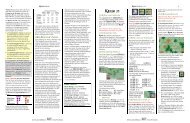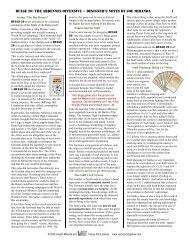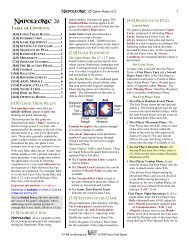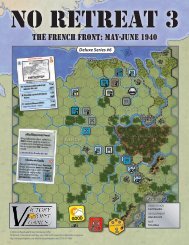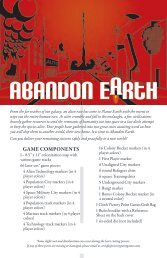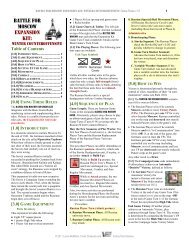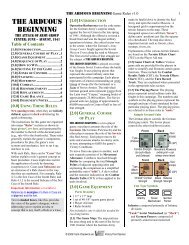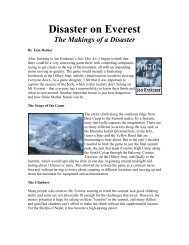Untitled - Victory Point Games
Untitled - Victory Point Games
Untitled - Victory Point Games
You also want an ePaper? Increase the reach of your titles
YUMPU automatically turns print PDFs into web optimized ePapers that Google loves.
6 The African Wars Standard Game Rules v1.0<br />
Procedure<br />
[9.1] Declare Attacks: The player<br />
declaring the attack during their Combat<br />
Step is the “Attacker” and the other player<br />
is the “Defender,” regardless of the overall<br />
strategic situation.<br />
The Attacker begins their Combat Step by<br />
declaring all of the Battles they will<br />
initiate that turn (i.e., which units will<br />
attack which enemy units, in which hexes)<br />
before any are resolved. Then, each<br />
individual Battle is resolved, one at a time<br />
(plus Momentum Attack follow-ups; see<br />
9.7), in any order the Attacker desires.<br />
A previously-declared Battle for that turn<br />
cannot be called off after seeing the results<br />
of earlier Battles; it must still be conducted!<br />
[9.2] Resolving Combat: A unit’s Combat<br />
Strength is the number of dice it rolls (die<br />
rolls are shown as this symbol: z) in its<br />
effort to score Hits against enemy units.<br />
Most units have a single Combat Strength,<br />
but some have two: e.g., 0/1, or 1/2. The<br />
first number is its “Attack Strength,”<br />
which is the number of dice it rolls when it<br />
is attacking; the second number is its<br />
“Defense Strength” and is used when that<br />
unit is defending. A ‘0’ Attack Strength<br />
means that unit cannot attack, but it does<br />
still defend using its Defense Strength.<br />
[9.3] Terrain/Supply Effects on Combat:<br />
During Step C of the Battle Sequence, refer<br />
to the Terrain Effects Chart. It explains<br />
how terrain affects the current Battle with a<br />
reduction of the number of dice thrown by<br />
the Attacker. These effects are:<br />
[9.3.1] Defending Across Hexsides:<br />
Certain hexsides (e.g., River hexsides),<br />
when between the hex the Attacking<br />
units occupy and any adjacent hexes<br />
occupied by Defending units in that<br />
Battle, subtract the indicated number of<br />
Attacker’s dice, but only from among<br />
those specific units attacking across the<br />
terrain-affected hexsides at that Battle.<br />
After these dice have been subtracted,<br />
check the terrain in the Defender’s hex.<br />
[9.3.2] Defender’s Terrain: After the<br />
hexside terrain dice are subtracted from<br />
the Attacker’s roll, if the targeted<br />
defending hex terrain benefits the<br />
defense, subtract the indicated number of<br />
dice from the Attacker’s total Red +<br />
Black dice that remain. If the defenders<br />
occupy one or more hexes with more<br />
than one different terrain type, apply the<br />
single terrain benefit that is most<br />
advantageous to the Defender.<br />
[9.3.3] Supply: Unsupplied attacking<br />
units cannot attack. Unsupplied defending<br />
units roll one fewer die (i.e., -1 z).<br />
[9.3.4] Red Dice First: Each subtraction<br />
of dice performed must be from the Red<br />
dice (z) in that group first.<br />
[9.3.5] Restricted Attacks: Units with<br />
Red Movement Allowances (i.e., Tank<br />
and Motorized units) can attack into<br />
Marsh and Forest terrain hexes only if a<br />
Road crosses the hexside between their<br />
hex and the Defender’s target hex.<br />
Example: Four units attack a unit in a Forest<br />
hex as illustrated below:<br />
At first, the dice roll sums look pretty good for<br />
the Attacker with z z z + z z attacking<br />
dice versus z<br />
z defending<br />
dice, but it looks<br />
very different<br />
after checking for<br />
terrain effects!<br />
Checking for<br />
hexside effects first (9.3.1), the two green<br />
units are attacking across a River hexside<br />
(shown by the blue arrow) with z z + z. The<br />
River hexside subtracts two dice from among<br />
all the units conducting cross-hexside attacks at<br />
that Battle, and Red dice are always subtracted<br />
first (9.3.4), so the adjusted strength of the<br />
cross-river Attackers is reduced to z.<br />
Next, the terrain in the Defender’s hex itself is<br />
considered (9.3.2). This is then subtracted from<br />
Systems Development by Bryan Armor with Alan Emrich



